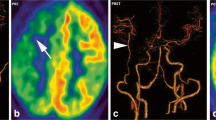Summary
Cerebral blood flow (CBF) and cerebrovascular reserve capacity (CRC) were measured by stable xenon computerized tomography (Xe-CT) and acetazolamide test in 15 patients with cerebrovascular disease before and after extracranial-intracranial (EC-IC) bypass surgery for minor stroke, reversible ischemic neurological deficit or transient ischemic attack. All had angiographically shown occlusive lesions of the major arterial trunk. In the present series, global analysis showed that the bypass did not increase the resting rCBF, but did increase the rCRC. We divided the patients into four groups according to the preoperative resting rCBF and rCRC. All 3 patients with normal resting rCBF and reduced rCRC showed postoperative improvement of rCRC. Of 6 patients with reduced CBF and reduced CRC, three had postoperative increase in resting CBF and four had increased CRC. One of two patients with reduced CBF and normal CRC showed only an increase in CRC. We propose that reduced CRC or reduced CBF with reduced CRC are criteria for selection of candidates for bypass surgery. We conclude that Xe-CT with the Diamox test is a useful and simple method for evaluating cerebral hemodynamics. Preoperative grouping with a combination of preoperative resting cCBF and preoperative rCRC is useful for predicting the effect of EC-IC bypass surgery.
Similar content being viewed by others
References
The EC-IC Bypass Study Group (1985) Failure of extracranial-intracranial arterial bypass to reduce the ischemic stroke. N Engl J Med 313:1191–1200
Ausmann JI, Diaz FG (1986) Critique of the extracranial-intracranial bypass study. Surg Neurol 26:218–221
Day AL, Rhoton AL, Little JR (1986) The extracranial-intracranial bypass study. Surg Neurol 26:222–226
Vorstrup S, Lassen NA, Henriksen L, Haase J, Lindewald H, Boysen G, Paulson OB (1985) CBF before and after extracranial-intracranial bypass surgery in patients with ischemic cerebrovascular disease studied with xenon-133 inhalation tomography. Stroke 16:616–626
Baron JC, Bousser MG, Rey A, Guillard A, Comar D, Castaigne P (1981) Reversal of focal “misery-perfusion syndrome” by extra-intracranial arterial bypass in hemodynamic cerebral ischemia; A case study with15O positron emission tomography. Stroke 12:454–459
Gibbs JM, Wise RJS, Leenders KL, Jones T (1984) Evaluation of cerebral perfusion reserve in patients with carotid-artery occlusion. Lancet I:310–314
Herold S, Brown MM, Frackowiak RSJ, Mansfield AO, Thomas DJ, Marshall J (1988) Assessment of cerebral haemodynamic reserve — correlation between PET parameters and CO2 reactivity measured by intravenous133xe injection technique. J Neurol Neurosurg Psychiat 51:1045–1050
Norrving B, Nilsson B, Risberg J (1982) rCBF in patients with carotid occlution — resting and hypercapnic flow related to collateral pattern. Stroke 13:155–162
Sullivan HG, Kingsbury TB, Morgan ME, Jeffcoat RD, Allison JD, Goode JJ, McDonnell DE (1987) The rCBF response to Diamox in normal subject and cerebrovascular disease patients. J Neurosurg 67:525–534
Vorstrup S, Henriksen L, Paulson OB (1984) Effect of acetazolamide on cerebral blood flow and cerebral metabolic rate for oxygen. J Clin Invest 74:1634–1639
Kashiwagi S, Yamashita T, Abiko S, Aoki H, Maekawa T, Takeshita H, Suess C, Kalender W (1986) Measurement and imaging of cerebral blood flow with stable xenon and computed tomography (Xe-CT). Electromedica 54:136–144
Koeppe RA, Holden JE, Ip WR (1983) Performance comparison of parameter estimation techniques for the quantitation of local cerebral blood flow by dynamic positron computed tomography. J Cereb Blood Flow Metab 5:224–234
Vorstrup S, Brun B, Lassen NA (1986) Evaluation of the cerebral vasodilatory capacity by the acetazolamide test before EC-IC bypass surgery in patients with occlusion of the internal carotid artery. Stroke 17:1291–1298
Author information
Authors and Affiliations
Rights and permissions
About this article
Cite this article
Yamashita, T., Kashiwagi, S., Nakano, S. et al. The effect of EC-IC bypass surgery on resting cerebral blood flow and cerebrovascular reserve capacity studied with stable Xe-CT and acetazolamide test. Neuroradiology 33, 217–222 (1991). https://doi.org/10.1007/BF00588221
Received:
Issue Date:
DOI: https://doi.org/10.1007/BF00588221




